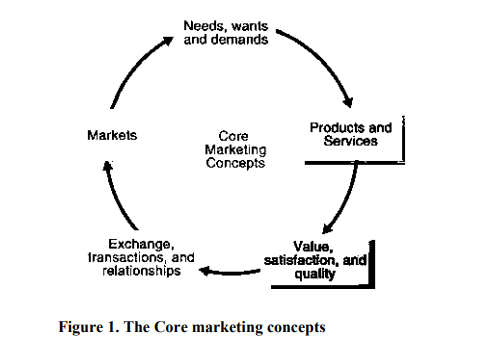The core marketing concepts help to understand the basic principles of marketing. The core concepts include:
- Needs, wants, demands
- Products and services
- Customer value, satisfaction and quality
- Exchange, transactions and relationships
- Market
The core concepts can be summarized in Figure 1 as shown below:

Let us see briefly the core marketing concepts:
Needs, Wants, and Demands
The most basic concept underlying marketing is that of human needs. Human needs are states of felt deprivation. They include basic physical needs for food, clothing, warmth, and safety; social needs for belonging and affection; and individual needs for knowledge and self-expression.
These needs were not invented by marketers; they are a basic part of the human makeup. Wants are the form human needs take as they are shaped by culture and individual personality. An East African needs food but wants Ugali or staple regional dish. Wants are shaped by one’s society and are described in terms of objects that will satisfy needs. People have almost unlimited wants but limited resources. Thus, they want to choose products that provide the most value and satisfaction for their money. When backed by buying power, wants become demands. Consumers view products as bundles of benefits and choose products that give them the best bundle for their money.
Products and Services
People satisfy their needs and wants with products. A product is anything that can be offered to a market to satisfy a need or want. The concept of product is not limited to physical objects; anything that is capable of satisfying a need can be called a product. In addition to tangible goods, products include the intangible product, such as, services, which are activities or benefits offered for sale that are essentially intangible and do not result in the ownership of anything.
Examples include the services offered by banks, airlines, hotels, lawyers, accounting professionals, doctors, and mechanics.
Generally, the concept product includes:
- Goods ( example, soap, television, mobile handsets)
- Services ( example, haircuts, financial planning, and other product offered by accounts, doctors, painters, musicians, repairers, etc)
- Experiences ( a trip to the peak of Mount Kilimanjaro, Mount Kenya, Lake Turkana, etc.,)
- Persons ( Examples, marathon winners, football stars, etc)
- Places ( example, location spot, cities, such as Masaai Mara, the Caribbean beach, Lake Naivasha, Cape Town, etc.,)
- Organizations ( Red Cross, National bank, etc,)
- Events ( example, World Cup, Olympics)
- Information ( knowledge created and disseminated by universities through teaching and publications; by media through publications, etc., )
- Ideas ( example, “ eat healthy food”; organizations’ or individuals’ doctrines, philosophies, etc., )
Thus, the term product includes much more than just physical goods or services. Consumers decide which events to experience, which dancers to watch on television, which places to visit on vacation, which organizations to support through contributions, and which ideas to adopt. To the consumer, these are all products.
Value, Satisfaction, and Quality
Customer value is the difference between the values the customer gains from owning and using a product and the costs of obtaining the product. Customers often do not judge product values and costs accurately or objectively. They act on perceived value.
Customer satisfaction depends on a product’s perceived performance in delivering value relative to a buyer’s expectations. If the product’s performance falls short of the customer’s expectations, the buyer is dissatisfied. If performance matches expectations, the buyer is satisfied. If performance exceeds expectations, the buyer is delighted. Satisfied customers make repeat purchases, and they tell others about their good experiences with the product. The key is to match customer expectations with company performance.
Customer satisfaction is closely linked to quality. In recent years, many companies have adopted total quality management (TQM)
programs, designed to constantly improve the quality of their products, services, and marketing processes. Quality has a direct impact on product performance and hence on customer satisfaction.
Exchange, Transactions, and Relationships
Marketing occurs when people decide to satisfy needs and wants through exchange. Exchange is the act of obtaining a desired object from someone by offering something in return. Exchange is only one of many ways that people can obtain a desired object. Exchange allows a society to produce much more than it would with any alternative system. Whereas exchange is the core concept of marketing, a transaction, in turn, is marketing’s unit of measurement. A transaction consists of a trade of values between two parties: One party gives money; another part, say, gets books in return.
Beyond creating short-term transactions, marketers need to build long-term relationships with valued customers, distributors, dealers, suppliers and others. They want to build strong economic and social connections by promising and consistently delivering high-quality products, and fair prices. Increasingly, marketing is shifting from trying to maximize the profit on each individual
transaction to building mutually beneficial relationships with consumers and other parties, such as customers, employees, suppliers, distributors, and retailers.
Markets
The concepts of exchange and relationships lead to the concept of a market. A market is the set of actual and potential buyers of a product. The size of a market depends on the number of people who exhibit the need, have resources to engage in exchange, and are willing to offer these resources in exchange for what they want.
